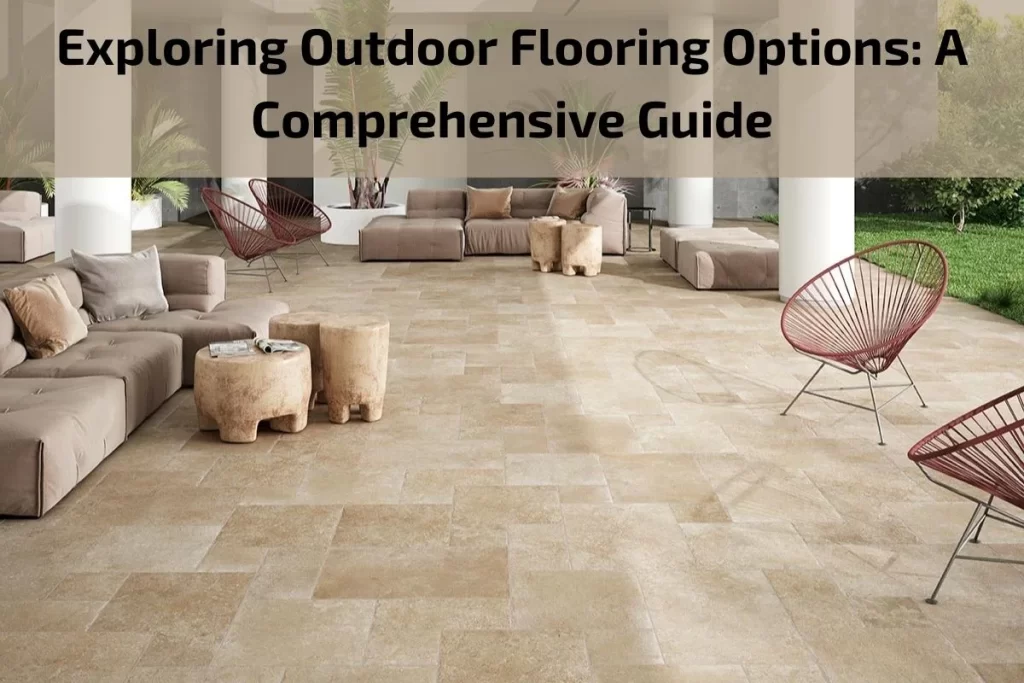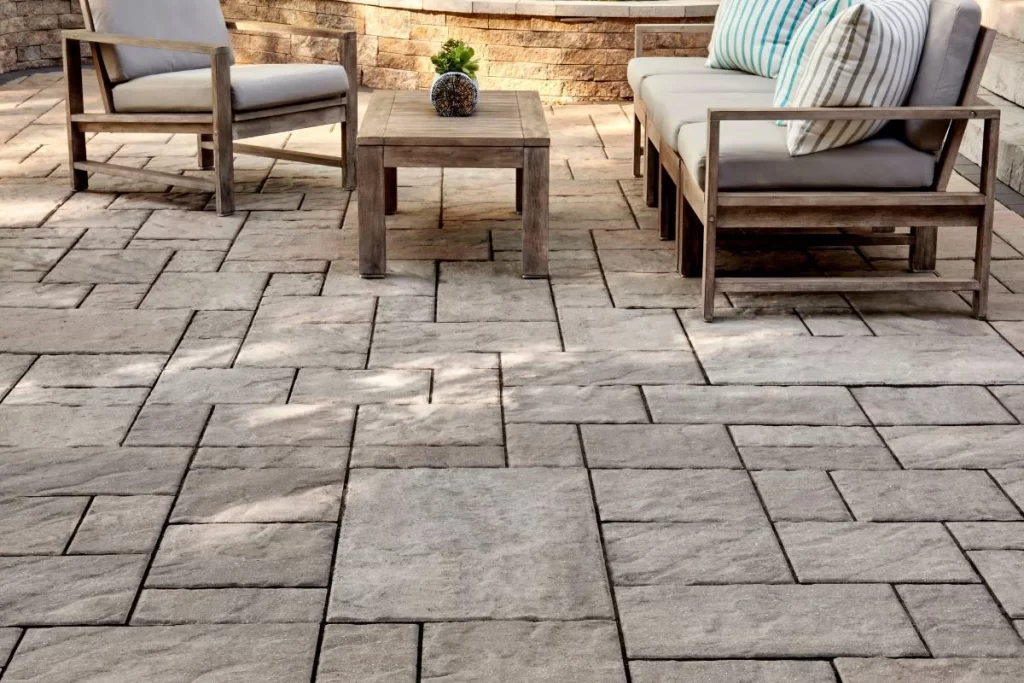
When it comes to designing and enhancing outdoor spaces, one of the most critical elements to consider is the flooring. Outdoor flooring serves as the foundation of your patio, deck, or garden area, setting the tone for the entire ambiance and functionality of the space. From providing durability and safety to adding aesthetic appeal and character, outdoor flooring plays a crucial role in creating inviting and enjoyable outdoor environments.
In this comprehensive guide, we’ll delve into the world of outdoor flooring options, exploring a wide range of materials, styles, and considerations to help you make informed decisions for your outdoor projects. Whether you’re renovating an existing patio, building a new deck, or designing a cozy garden retreat, understanding the diverse array of outdoor flooring choices will empower you to create a personalized and functional outdoor living space that suits your lifestyle and preferences.
Importance of Outdoor Flooring in Enhancing Outdoor Spaces
Outdoor flooring serves as the foundation of any outdoor area, playing a crucial role in enhancing its functionality, aesthetics, and overall appeal. Here’s why outdoor flooring is essential in transforming outdoor spaces:
Defining Space and Functionality: Outdoor flooring helps delineate different areas within an outdoor space, such as dining areas, lounging zones, and pathways. By defining these spaces, outdoor flooring enhances the functionality of the area, making it more conducive to various activities and purposes, whether it’s entertaining guests, relaxing with family, or enjoying outdoor meals.
Creating Visual Appeal and Atmosphere: The choice of outdoor flooring significantly impacts the visual appeal and atmosphere of an outdoor space. Whether you opt for natural stone, wood decking, or porcelain tiles, the texture, color, and pattern of the flooring can set the tone for the entire outdoor area. Well-chosen outdoor flooring materials can complement the surrounding landscape, architecture, and design elements, creating a cohesive and inviting environment.
Adding Comfort and Safety: Comfort and safety are paramount considerations when designing outdoor spaces. High-quality outdoor flooring materials, such as soft wood decking or non-slip tiles, can enhance comfort underfoot and reduce the risk of slips and falls, especially in areas prone to moisture or high foot traffic. The right outdoor flooring also provides a stable and level surface for furniture, allowing for comfortable seating and lounging experiences.
Durability and Weather Resistance: Outdoor flooring is subjected to harsh environmental conditions, including sunlight, rain, snow, and temperature fluctuations. Therefore, it’s essential to choose durable and weather-resistant materials that can withstand the elements and maintain their integrity over time. Properly selected and installed outdoor flooring can resist fading, warping, rotting, and other forms of damage, ensuring long-term performance and longevity.
Ease of Maintenance: Low-maintenance outdoor flooring options are preferred by homeowners seeking to minimize upkeep and maximize enjoyment of their outdoor spaces. Many outdoor flooring materials, such as composite decking and porcelain tiles, require minimal maintenance beyond regular cleaning and occasional sealing. By selecting low-maintenance flooring, homeowners can spend more time relaxing and entertaining outdoors without the hassle of constant upkeep.
Eco-Friendly and Sustainable Outdoor Flooring Alternatives
In recent years, there has been a growing awareness of the environmental impact of outdoor flooring materials, prompting homeowners and designers to seek eco-friendly and sustainable alternatives. Here are some environmentally conscious options for outdoor flooring:
Recycled Materials: Utilizing recycled materials for outdoor flooring is an effective way to reduce waste and minimize environmental impact. Recycled rubber pavers, for example, are made from discarded rubber tires and offer a durable and slip-resistant surface for patios, walkways, and playgrounds. Similarly, recycled plastic lumber composed of post-consumer plastic waste can be used for decking and landscaping projects, providing a sustainable alternative to traditional wood.
Bamboo Decking: Bamboo is a rapidly renewable resource that offers an eco-friendly alternative to traditional wood decking materials. Bamboo decking is highly durable, insect-resistant, and easy to maintain, making it an attractive option for outdoor applications. Additionally, bamboo grows quickly and can be harvested sustainably, making it an environmentally responsible choice for outdoor flooring projects.
Permeable Pavers: Permeable pavers are designed to allow rainwater to infiltrate through the surface and replenish groundwater resources, reducing storm water runoff and preventing erosion. Made from materials such as concrete, recycled glass, or natural stone, permeable pavers help mitigate flooding, filter pollutants, and promote sustainable water management practices in outdoor environments. They are ideal for driveways, walkways, and patio areas where water drainage is a concern.
Cork Flooring: Cork is a renewable and biodegradable material harvested from the bark of cork oak trees. Cork flooring offers excellent thermal insulation, sound absorption, and cushioning properties, making it an ideal choice for outdoor spaces where comfort and sustainability are priorities. Cork flooring is resistant to mold, mildew, and insects, making it suitable for use in humid or damp climates.
Grass Pavers: Grass pavers combine the structural support of traditional pavers with the aesthetic appeal of natural grass, allowing for the permeation of water and the growth of vegetation. Grass pavers are commonly used for parking lots, driveways, and fire lanes, providing a green alternative to traditional pavement while reducing heat island effects and promoting stormwater management.
Composite Decking: Composite decking is made from a blend of recycled wood fibers and plastic materials, offering the look of natural wood with the durability and low maintenance of composite materials. Composite decking is resistant to rot, mold, and insects, eliminating the need for chemical treatments and prolonging the lifespan of outdoor flooring. It is available in a variety of colors and finishes, allowing homeowners to achieve the desired aesthetic without compromising sustainability.

Advantages and Disadvantages of sustainable outdoor flooring
Advantages of Sustainable Outdoor Flooring:
Environmental Conservation: Sustainable outdoor flooring options utilize renewable resources, recycled materials, or eco-friendly manufacturing processes, reducing the depletion of natural resources and minimizing environmental impact.
Reduced Carbon Footprint: Many sustainable outdoor flooring materials require fewer resources and energy to produce, resulting in lower carbon emissions compared to traditional options. This helps mitigate climate change and promote environmental sustainability.
Waste Reduction: By incorporating recycled materials or utilizing renewable resources, sustainable outdoor flooring contributes to waste reduction and landfill diversion, supporting circular economy principles and reducing the burden on waste management systems.
Improved Air and Water Quality: Sustainable outdoor flooring materials often contain low VOC (volatile organic compound) levels and are free from harmful chemicals, promoting healthier indoor and outdoor air quality. Additionally, permeable and porous flooring options facilitate rainwater infiltration, reducing stormwater runoff and preventing water pollution.
Durability and Longevity: Many sustainable outdoor flooring materials, such as bamboo, cork, and composite decking, offer exceptional durability and longevity, requiring less frequent replacement and maintenance compared to traditional materials. This results in cost savings and reduced environmental impact over the long term.
Disadvantages of Sustainable Outdoor Flooring:
Higher Initial Cost: Sustainable outdoor flooring materials may have a higher initial cost compared to conventional options, primarily due to factors such as raw material sourcing, production methods, and niche market demand. This can pose a barrier for homeowners with limited budgets or cost-sensitive projects.
Limited Design Options: Sustainable outdoor flooring options may have limited design versatility or aesthetic appeal compared to traditional materials. While eco-friendly materials are continually improving in terms of aesthetics and variety, some homeowners may find the available options restrictive or less customizable.
Maintenance Requirements: Certain sustainable outdoor flooring materials may require specialized maintenance procedures or products to preserve their appearance and performance over time. For example, bamboo decking may require periodic sealing or refinishing to protect against moisture and UV exposure, adding to maintenance costs and efforts.
Availability and Accessibility: Depending on geographic location and market demand, sustainable outdoor flooring materials may be less readily available or accessible compared to conventional options. Limited availability may result in longer lead times, higher shipping costs, or difficulty sourcing specific materials for outdoor projects.
Performance Considerations: While many sustainable outdoor flooring options offer excellent durability and performance, some materials may have specific limitations or performance issues in certain environmental conditions. For example, natural materials like cork or grass pavers may be susceptible to damage from moisture, pests, or extreme weather conditions, requiring careful consideration of local climate and site conditions.
Design Ideas and Inspirations for Outdoor Flooring Projects
Designing outdoor flooring projects involves creativity, functionality, and aesthetic appeal. Here are some design ideas and inspirations to help elevate your outdoor spaces:
Mix and Match Materials: Combine different outdoor flooring materials to create visual interest and define various zones within your outdoor space. For example, pair natural stone tiles with wood decking or incorporate decorative concrete pavers with gravel pathways to add texture and dimension to your patio or garden area.
Create Patterns and Borders: Experiment with geometric patterns, borders, and insets to add a custom touch to your outdoor flooring design. Consider using contrasting colors or alternating tile sizes to create eye-catching patterns that enhance the visual appeal of your outdoor space.
Embrace Natural Elements: Incorporate natural elements such as pebbles, river rocks, or reclaimed wood into your outdoor flooring design to connect with the surrounding environment and create a tranquil, organic atmosphere. Use natural materials as accents or focal points to add warmth and character to your outdoor space.
Opt for Low-Maintenance Options: Choose outdoor flooring materials that require minimal upkeep and maintenance to keep your outdoor space looking pristine year-round. Consider options like composite decking, porcelain tiles, or permeable pavers that offer durability, ease of cleaning, and long-term performance with minimal effort.
Create Visual Continuity: Extend your indoor living space outdoors by selecting outdoor flooring materials that complement your interior design aesthetic. Choose colors, textures, and finishes that create a seamless transition between indoor and outdoor areas, blurring the boundaries between the two and enhancing the overall flow of your home.
Incorporate Greenery: Integrate landscaping elements such as planter boxes, raised beds, or living walls into your outdoor flooring design to add lushness and greenery to your space. Use outdoor flooring materials that allow for vegetation growth, such as grass pavers or permeable surfaces, to create a harmonious balance between hardscape and softscape elements.
Consider Lighting Effects: Enhance the ambiance and functionality of your outdoor space with strategic lighting effects integrated into your flooring design. Incorporate recessed LED lights, solar-powered path lights, or string lights along pathways, decking edges, or outdoor seating areas to create a welcoming and inviting atmosphere during evening gatherings or outdoor entertaining.
Personalise with Accents and Accessories: Add personality and charm to your outdoor flooring design with decorative accents and accessories. Incorporate outdoor rugs, throw pillows, decorative planters, and outdoor furniture to infuse color, texture, and style into your space, reflecting your personal taste and lifestyle preferences.

Maintenance and Care Tips for Outdoor Flooring
Proper maintenance and care are essential for preserving the beauty, functionality, and longevity of outdoor flooring materials. Here are some practical tips to help you maintain and care for your outdoor flooring:
Regular Cleaning: Establish a routine cleaning schedule to remove dirt, debris, and organic matter from the surface of your outdoor flooring. Use a broom, leaf blower, or outdoor vacuum to sweep away leaves, twigs, and other debris regularly. For stubborn stains or buildup, use a mild detergent solution and a soft-bristled brush to gently scrub the surface, then rinse thoroughly with water.
Avoid Harsh Chemicals: When cleaning outdoor flooring, avoid using harsh chemicals, bleach, or abrasive cleaners that may damage or discolor the surface. Instead, opt for environmentally friendly cleaning products specifically formulated for outdoor use, or make your own DIY cleaning solutions using natural ingredients like vinegar and baking soda.
Preventative Maintenance: Take proactive measures to prevent damage and wear on your outdoor flooring. Place furniture pads or coasters underneath outdoor furniture legs to prevent scratching or indentations on the surface. Use outdoor rugs or mats in high-traffic areas to protect the flooring from excessive wear and tear.
Sealing and Waterproofing: Depending on the type of outdoor flooring material, consider applying a sealant or waterproofing treatment to enhance durability and weather resistance. Sealants help protect porous materials like natural stone, concrete, and wood from moisture penetration, staining, and deterioration caused by exposure to the elements.
Inspect for Damage: Regularly inspect your outdoor flooring for signs of damage, such as cracks, chips, or loose tiles. Address any issues promptly to prevent them from worsening over time. Replace damaged or broken tiles, pavers, or decking boards as needed to maintain the integrity and safety of the outdoor flooring surface.
Protect Against Weathering: Minimize exposure to harsh weather conditions by providing adequate shelter or coverage for outdoor flooring areas whenever possible. Consider installing awnings, pergolas, or shade sails to protect decking, tiles, and pavers from prolonged exposure to sunlight, rain, and snow, which can cause fading, warping, or deterioration over time.
Manage Vegetation Growth: Keep vegetation and landscaping elements in check to prevent them from encroaching on outdoor flooring surfaces. Trim back overhanging branches, vines, and shrubs to prevent debris buildup and minimize the risk of moisture retention, mold growth, and pest infestation on the flooring.
Winter Preparation: In colder climates, take precautions to protect outdoor flooring from frost, ice, and freezing temperatures during the winter months. Clear away snow and ice promptly to prevent moisture damage and minimize the risk of slips and falls on slippery surfaces. Use ice melt products sparingly and avoid using metal shovels or tools that may scratch or damage the flooring.
Conclusion
Maintaining outdoor flooring is crucial for preserving its aesthetics, functionality, and durability over time. By implementing regular cleaning routines, preventative maintenance measures, and proactive care strategies, homeowners can extend the lifespan of their outdoor flooring and ensure its continued performance in various weather conditions.

